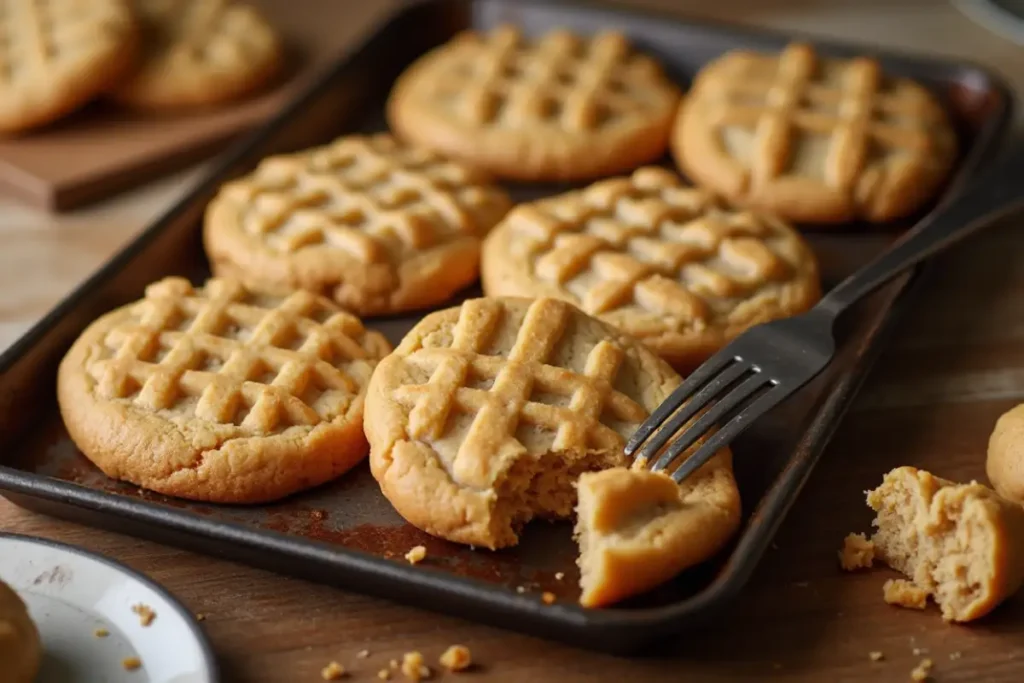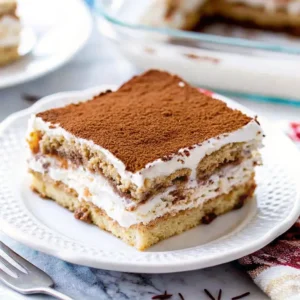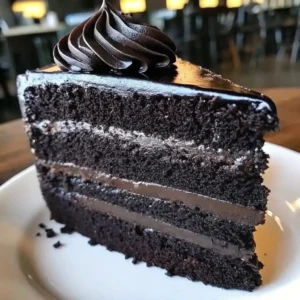The peanut butter cookie has earned its well-deserved place among the most loved treats around the world. Their salty, nutty, and sweet flavor is what makes them so appealing. However, one factor that separates these cookies from the rest is their famous cross-cut fork marks. Fork marks in peanut butter cookies are more than just decorative—they serve a practical purpose. If you’ve wondered why bakers use this unique feature, it’s not a mystery. Let’s discover the fascinating reason behind the fork marks on peanut butter cookies.
Table Of Contents
Table of Contents
The History of Peanut Butter Cookies
To understand the significance of fork marks it’s important to travel through time. Peanut butter cookies first became popular in the 20th century, when peanut butter was a staple in the household. The first recipe known to be used to make peanut butter biscuits was found in a cookbook released in the decade of 1910. But it was only in the 1930s that the fork mark trend was introduced.
It is interesting to note that the crisscross motif was first made popular through Pillsbury within their cookbook from the 1930s. The straightforward instructions to press down the dough using a fork did not just make them more even in their shape but also gave them a distinctive appearance that quickly became associated with Peanut Butter Cookies.
The Science Behind Peanut Butter Cookies
Although peanut butter cookies might appear simple to make, there’s a lot of science going on in the background. The dough used for peanut butter cookies is more dense than other cookie dough due to the fat content that is high in peanut butter. The dough’s density is such that it does not spread as widely in baking, which can result in uneven cooking when not flattened properly.
Additionally, the texture of the dough is what can be a bit more difficult to work with. The flattening of the dough using a fork ensures that it bakes uniformly, which results in a crispy, crisp exterior as well as a soft, chewy middle.
Why Fork Marks?
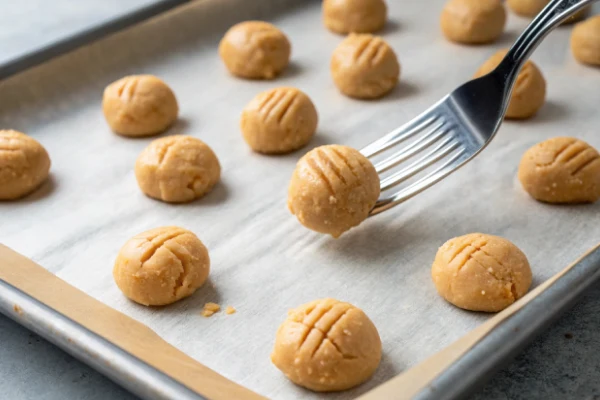
Practical Reasons for Fork Marks
Let’s get practical. The primary purpose behind the fork marks is to help flatten the dough. If you do not take this step and the cookies are not flat enough, they could be too dense in the center which can lead to a dough that is undercooked or different texture. When you press the dough using a fork, you aid in helping to spread it evenly, which ensures uniform baking.
Aesthetic Appeal
While the benefits of fork marks are unquestionable they also serve a decorative reason. The crisscross pattern creates an authentic charm that is instantly identifiable. It’s an easy but efficient way for your cookie to appear more professional and attractive.
Fork Marks and Cookie Texture
Its shape is as important as the flavor and fork marks play an important aspect in achieving that perfect balance. If the cookies are not flat, they could be gummy or too dense in the middle. The fork marks provide an even surface that ensures an even baking. This process aids in the development of cookies that have the perfect combination of a crisp exterior and a melting-in-your-mouth interior.
Furthermore, the marks made by a fork permit heat to be absorbed more evenly into the dough. This ensures that each piece of cookie will have the same tasty texture without unpleasant surprises such as an unbaked middle.
Creating the Iconic Crisscross Design
The art of making perfect marks for your fork is much simpler than you believe. Here’s the step-by-step process:
- Gather Your Equipment All you require is a dinner knife and maybe some sugar for a dip. The sugar keeps that fork from sticking to the bread and also adds an icy crunch.
- Roll the dough Form cookies made of peanut butter dough in uniform balls. This will help all of your cookies bake equally.
- Press using a Fork to dip the fork into sugar, then press the ball of dough. Turn the fork 90° and press the fork again to make the cross-shape.
If you like the idea of traditional peanut butter cookies You might also like making three ingredients in Peanut Butter Blossoms Easy and Quick Easy recipe. This recipe is a simple but delicious way for you to indulge in peanut butter snacks without sacrificing the flavor.
- Bake to perfection Once all of your cookies have been marked baked, follow the instructions for your recipe.
Cultural Significance of Fork Marks
For many, the practice of putting fork marks in the peanut butter cookie is a treasured tradition. It’s typically among the very first cooking methods that children are taught, which makes it a cherished tradition handed down from generation to generation. The crisscross pattern is an image of delicious home baking and bonding with family.
Cookies made of peanut butter, which are known for their distinctive look, are a staple on the cultural map. They’re frequently featured in movies and TV shows as the classic American dessert, further cementing their reputation as a cherished classic.
Tips for Making Perfect Peanut Butter Cookies
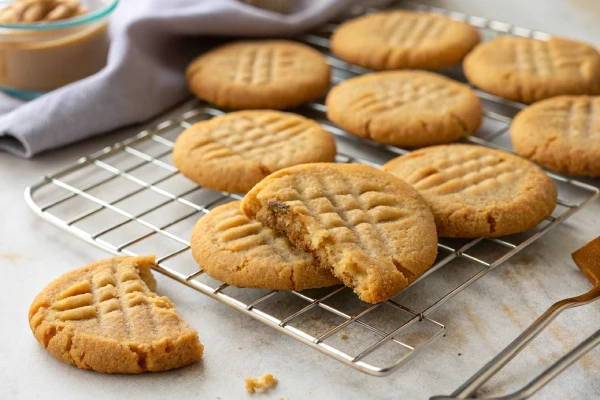
If you’re looking to achieve peanut butter cookie perfection, here’s some tips to help you get there:
- Choose the Best Peanut Butter It is important to note that both thick and creamy peanut butter are great However, make sure you make sure to use a peanut butter that is free of sugar or oil to get the best results.
- Chill the dough Refrigerating the dough for 30 minutes before baking will prevent spread and aid in keeping its shape.
- Don’t forget fork marks As we’ve already discussed this is a crucial step to ensure even baking.
- Use parchment paper Line your baking pan using parchment makes cleaning simpler and helps avoid sticking.
Variations of Fork Marks
While the classic crisscross design is the most popular pattern, you can be creative in your designs. Here are some ideas:
- Diagonal lines instead of crossing the fork marks, you can press into diagonal lines for an original design.
- Double Press Double Press: Press the fork two times in the direction of the fork to create an effect with a texture.
- Cookies Use a pattern cookie stamp to give a modern version of the traditional design.
Do Fork Marks Affect Taste?
It is possible to ask if marks from the fork have any effect on the taste. Although they do not directly alter the flavor, they are a crucial element during the baking process, that affects the overall texture and the mouthfeel. A cookie that has an unbalanced texture may taste different due to the way it interacts with your mouth. So, the marks made by a fork can indirectly enhance the taste of a cookie, as they guarantee that it’s been baked.
Fun Facts About Peanut Butter Cookies
- The Fork Mark Origin: Pillsbury’s 1930s-era cookbook was the first to use the crisscross pattern as a baking technique for peanut butter cookies.
- Peanut Butter Popularity: Peanut butter was an essential ingredient in the household throughout the Great Depression because it was cheap and nutrient-rich.
- National Peanut Butter Cookie Day The celebration of this tasty treat each year on the 12th of June.
- World Record Cookie The biggest peanut butter cookie ever created that weighed more than 40,000 lbs!
- Gluten-free Option If you follow the correct recipe Peanut Butter Cookies can be created gluten-free.
Others Cookies with Signature Designs
Cookies made of peanut butter are not the only ones that have a distinctive appearance. Here are some examples:
- Thumbprint Cookies Cookies that are made with the thumb to make an indentation that is used to create chocolate or jam.
- Checkerboard Cookies: They require precision to create their appealing design, but are worthy of the time and effort.
- cookies with Spritz Created using cookie presses and buttery cookies, they come in a wide variety of styles and shapes.
The Future of Peanut Butter Cookies
As baking trends continue to change the peanut butter cookie is getting redesigned with new twists. Bakers are exploring alternative nuts, adding caramel or chocolate drizzles, and adding unexpected ingredients like chili powder or sea salt. Despite these new developments, however, the classic fork marks are a cherished tradition, and preserve the timeless beauty of these delicious cookies.
Conclusion
The fork marks on the peanut butter cookies are more than just a decorative feature. They’re an essential part of baking as a nod to the past as well as a symbol of home-cooked comfort. No matter if you’re a pro baker or new to the kitchen, making these crisscross designs is a great method to enhance those peanut butter biscuits, and connect to the rich past of baking.
FAQs
What is the reason why peanut butter cookies have to be flattened?
The peanut cookies made of butter are a bit dense and don’t spread as much in baking. It helps to cook evenly.
What can I do with an ordinary spoon instead of a fork to flatten?
Yes, however, the fork makes the distinctive crisscross pattern making peanut butter biscuits immediately recognized.
What happens if I skip the marks on my fork?
The mistake of not marking the marks could result in uneven baking with certain areas of the cookies being undercooked or too heavy.
Are there any fork marks I can make on different kinds of cookies?
Absolutely! The marks of a fork can bring texture and awe to any cookie recipe however they’re the most well-known in peanut butter cookies.
Are there alternatives to making fork marks on peanut butter cookies?
You can make use of cookie stamps or the spoon’s back to create an original design however, the crisscross is the most popular design.
